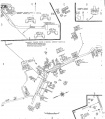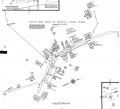Virginia State Epileptic Colony
| Virginia State Epileptic Colony | |
|---|---|
 | |
| Established | 1910 |
| Opened | 1911 |
| Closed | 2020 |
| Current Status | Closed |
| Building Style | Cottage Plan |
| Location | Lynchurg, VA |
| Architecture Style | Colonial Revival |
| Peak Patient Population | 2,347 in 1956 |
| Alternate Names |
|
Contents
History
Established as the Virginia State Epileptic Colony in 1910, the facility is located on a tract of land overlooking the James River in Amherst County. The property, known as "Morissana" was purchased from Bessie Willis and others in 1909, using funds obtained through the sale of the nearby "Murkland" tract that had been deeded to Western State Hospital in 1905. The facility was originally designed to serve 100 persons with epilepsy, to be drawn from the 3 state mental hospitals (Western, Eastern and Southwestern) existing at the time. The first patients were admitted on May 16, 1911.
The Drewry-Gilliam building was named in honor of Dr. William F. Drewry and Mr. Robert Gilliam of Petersburg for their efforts to secure a state facility for epileptics. Constructed at a cost of $24,420, the building, referred to as a "cottage," contained a dining room, laundry room, serving room, pantries, kitchen, cold storage room, toilet room and a coal storage room in the basement. The two upper stories contained two 40 bed wards, dormitories, living rooms, attendant’s rooms, linen rooms and lavatories. Other features of the original site plan included the three story colonial mansion "Morissana" which was renovated as the Executive/Administration Building.
There was also a brick, two story colonial cottage for 20 patients created by enlarging the existing servant’s house, a boiler and power house created from the existing stable, yards and sheds for hogs and cattle, and a newly constructed .76 mile spur track of the Norfolk and Western Rail Road to bring supplies to the facility. Starting in 1913, with the construction of the 60 bed Mastin-Minor building, the facility was prepared to accept "feeble-minded" women into residence.
In 1919, the average resident population of the Colony was 508, with 351 classed as epileptics and 157 characterized as "feeble-minded." The biennial report for 1919-21 stated that the facility name was changed to the State Colony for Epileptics and Feebleminded to reflect this change in the resident population. By 1926, the facility reported a population of 845, composed of 347 male and 164 female epileptics and 334 female mentally retarded patients.
Based on the uninformed view of mental illness and mental retardation that received both popular and scientific support at the time, the concept of sterilization for certain classes of facility residents may have been discussed from the time of its founding in 1910. However, in 1913, the facility superintendent noted that sterilization "can never become a general procedure, on account of the many objections that can be raised to it, nor in practical results compare with … segregation and custodial control…" (4th Annual Report, 1913). Unfortunately, in October of 1927, the Colony nevertheless became formally enmeshed in the now discredited "Eugenics" movement. Acting pursuant to a Virginia law (Chapter 394, Acts of the General Assembly, 1924) that was upheld by the U.S. Supreme Court in Buck v. Bell, the facility embarked on an ill-advised program of involuntary sterilization, combined with routine appendectomies, of so-called "mental defectives with cacogenic potentialities" (19th Annual Report, 1927-28). Although "Eugenic" sterilizations were last noted in the facility annual report for 1956, medical sterilizations may have continued until 1972.
In 1940, the type of individual served was omitted from the facility name, and it became known as simply the Lynchburg State Colony. During that year, the facility had 2019 residents under treatment, and, for the first time, allowed social visitation between male and female patients. According to the Superintendent, "We have continued to allow most of our male patients to call upon their female patient friends for a hour or so each Sunday afternoon. This radical experiment has proven to be a most successful one. Just how much this has been responsible for the diminution in the number of elopements from the Colony, I cannot say…".
In the early to mid 1950’s, national emphasis on development of training programs marked a new era in the field of mental retardation. A variety of new training programs were introduced for patients and, by 1955, two thirds of the residents had the benefit of training conducted by a staff of 28 teachers. Efforts were also made to increase staff skills. In 1952, a state approved attendant training program consisting of 115 hours of instruction in patient care was started at the Colony. By June of 1955, 155 attendants had completed the course and received a certificate of proficiency. In keeping with this change in focus, the General Assembly changed the facility’s name in 1954 to Lynchburg Training School and Hospital.
The farm that had been started in the earliest days of the Colony continued in operation, with varying degrees of success, into the 1950’s. In addition to the cultivation of soybeans, wheat, corn, vegetables and hay, the facility farm also maintained herds of Holstein dairy cattle and Duroc, Yorkshire and Berkshire hogs. The farm, which employed many of the facility residents, usually operated at a profit. However, specific events such as the loss of the barn and contents to fire in 1921, variations of market prices for farm produce, and seasonal weather patterns resulting in drought or excessive moisture, did occasionally cause deficit operations for the year. In 1958, the cow barn was torn down and the dairy barn converted to a temporary dormitory. By 1968, all that remained of farm operations was a greenhouse for horticulture that had been constructed and maintained with Federal funding.
Client population continued to increase during the 1950’s, and reached 2,347 in 1956. This led to unavoidable overcrowding, and, in 1957, an admission rate of 5 per week was established as a guide and control for space management. After 62 new beds were added in 1962 and 284 in 1963, the admission rate raised to 6 per week in 1964 and 7 per week in 1965. This increased rate of admissions naturally continued to raise the overall resident population, even though the facility had stopped the practice of holding patients for Western State Hospital in 1967. Finally, when the resident population reached 3686 in 1972, the facility found it necessary to discontinue admissions altogether.
By 1979, overcrowding and admissions pressure on the facility had been reduced by the State's creation of 3 additional regional centers to care for the mentally retarded. This expansion and other factors such as the creation of Community Service Boards and the establishment of discharge planning as an integral part of the admissions procedure, had reduced the LTS&H resident population to 2154. The remaining residents ranged in age from 3 to 83, and were in the severe to profound range of mental retardation. Many also had severe physical disabilities.
On July 1, 1983, the facility’s name was changed to the Central Virginia Training Center to reflect its geographic location. A year later, the campground for residents was opened, and the resident population had decreased to 1724. Between 1982 and 1984, the facility reflected a trend toward the care of the more seriously disabled population. Although there was an 8% overall decrease in population during this period, the percentage of residents classified as profoundly mentally retarded actually increased due to the dramatic reduction in the number higher functioning residents through community placement.
The U.S. Department of Justice began a three-year investigation into CVTC and other training centers in 2008. The investigation found Virginia harmed patients in training centers by keeping them in institutions, finding residents had little to no interaction with those who are not disabled, denied freedoms of choice and sometimes physically or chemically restrained. The Department of Justice demanded the state shut down training centers and, in 2012, Virginia agreed to close all but one. That year, the CVTC had 360 residents and 1,250 employees.
The Lynchburg Regional Business Alliance announced the first stages of a redevelopment plan for the Central Virginia Training Center in Madison Heights in 2020.
Cemetery
Since its creation, the facility has maintained a 6 acre cemetery on grounds. The first recorded burial, that of a 16 year old boy, took place on June 27, 1911, a little over one month after the first patients were admitted. As of January 2005, the cemetery held 1028 graves. Most interments were of the men, women and children who lived at the facility. One such grave is that of a facility resident who was a Confederate veteran, having served as a private with Co. F, 37th VA Infantry. A few graves, however, hold clients of other state facilities and one grave is marked "Unknown." CVTC maintains a complete record of all burials that includes grave number, name, date of birth and date of death. To request access to the cemetery grounds, please contact the CVTC Police Department in advance at 434-947-6136
Images
Links
Training Center Redevelopment website http://trainingcentermasterplan.com/



